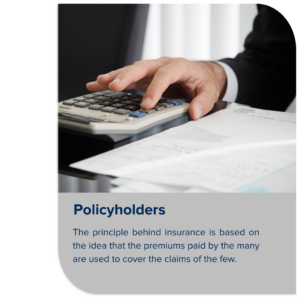FAQs – Insurance Pricing
FAQs – Insurance Pricing
The way which insurers calculate the costs associated with an insurance policy can be a complicated process due to several factors, factors which impact these decisions and heavily influence the level of risk determined to be associated with any one policy.
- What does my premium pay for?
- What influences my insurance cost?
- The Impact of Inflation
- Changes to Current insurance providers’ regulations
- A note on profits
![]() 1. What does my premium pay for?
1. What does my premium pay for?

The insurance industry is currently facing numerous challenges, which can make it even more difficult for customers. This is especially significant considering the period of high inflation we are currently experiencing.
When you pay your insurance premium, it becomes part of a larger collection of funds which are specifically set aside to cover the claims made by policyholders. The majority of the premium you pay is directed towards helping other customers who need financial compensation. The principle behind insurance is based on the idea that the premiums paid by the many are used to cover the claims of the few, which in severe cases, can add up to millions of pounds.
However, like any other profession, Insurers also need to cover the cost of doing business, including marketing and operational expenses. If these costs increase, it can have a major effect on the premiums they charge.
![]() 2. What influences my insurance cost?
2. What influences my insurance cost?
Different insurers also use different data to determine which factors have the most impact on the level of risk associated with a policy, and this can depend on a variety of things. One influence may be if an insurance company has a high number of previous claims associated to policies with a specific common trait.
For example, the price of your insurance policy partly reflects the likelihood of you having to make a claim in the future. It may be that your local area has experienced an increase in traffic accidents or thefts recently, which could result in a higher renewal quote where the risk of having to claim also increases. Alternatively, your insurer’s data may suggest that the make or model of your vehicle has become riskier, again based on statistics surrounding other vehicles of the same type.
Another example of this comes from listing an occupation when looking for a quote on car insurance, this can determine insights into what time of day the policy holder is likely to be driving or under what circumstances, which could influence the level of risk associated with the consumer.
A nurse driving home after a 12-hour shift is more likely to be at risk of an incident than a 9-5 worker, in the same way someone with a long journey home is more at risk than someone taking a 10-minute commute.

Furthermore, insurers may adjust their preferences for certain customer groups, such as older or younger drivers, and decide to increase or decrease their customer base in specific segments. This strategy also allows insurers to spread the risk of expensive claims by diversifying their portfolio ensuring they are not over exposed to any specific risk. These factors can impact the price that insurers charge for their services, in addition to the risk assessment calculations.
It is a priority for insurers that they are incredibly accurate upon determining these prices due to the need to ensure that everyone that needs to make a claim will be adequately insured in the event of doing so. However, Insurers cannot provide specifics to their pricing methods to ensure a fair market for consumers. This means, the insurance market remains competitive as companies continue to compete to provide the best quotes on premiums, meaning better prices for consumers.
![]() 3. The Impact of Inflation
3. The Impact of Inflation
With the rising value of certain items, and rising costs of repair and replacement across various lines of businesses, higher premiums are being set in order to ensure your policy adequately covers the necessary costs.
Currently in the UK, we are experiencing high inflation rates, which has resulted in increased costs across most industries; for example, the majority of expenses you might face following an insurance claim. Repairing damaged vehicles, replacing stolen items, and covering the expenses of medical procedures for pets have all gone up in value. Since a significant portion of insurance premiums is allocated towards claim payouts, rising costs may call for an increase in premiums.
With car insurance for example, we can understand why it might be frustrating or distressing to see prices rising when key factors such as your no-claims or the vehicle on the policy haven’t changed. However, as things such as paint and material costs and energy inflation add to the cost of making repairs, these factors impact heavily to what it costs to pay a claim for a theft or an accident.

Additionally, inflation in energy prices further adds to the costs of repair. Naturally, these factors have a significant impact on determining the cost of paying out a claim for theft or accidents. Despite this, naturally, it remains that the most crucial aspect of any insurance policy is to ensure that customers who suffer a loss receives the support they need when filing a claim.
However, it is still incredibly important to ensure you do not provide false information when applying for a new insurance quote. The risks can be far greater when underinsured as in the event of a claim the policy may be unable to cover the full amount needed to cover the costs of recovery.
An insurance company can also refuse to pay out altogether if they find misleading information was used in order to get cheaper premiums.
![]() 4. Changes to current Insurance Providers’ Regulations
4. Changes to current Insurance Providers’ Regulations
New regulations implemented by the FCA (Financial Conduct Authority) last year, prevent insurers from offering better introductory prices to new customers compared to renewing ones. This ensures fair pricing for all customers and eliminates the disparity between introductory and renewal premiums. New and existing customers now must be priced in the same way.
This pricing reform decision also shields customers who are not as knowledgeable about switching, ensuring they aren’t penalised for their loyalty, where previously customers would switch to a new company every time they were up for renewal in an attempt to get offered cheaper premiums also known as ‘price walking’.
![]() 5. A note on profits
5. A note on profits
Insurers, just like any other company, have the goal of making a profit in order to invest, expand, and generate returns for their shareholders or members. However, when it comes to motor insurance, the average profit margin is typically quite small, often just a single-digit percentage. In fact, many insurers even operate at a loss on motor coverage to retain customers and provide them with additional insurance options like home, pet, or travel insurance to make this back. Alternatively, an insurer may offset the losses from motor insurance by earning returns from investments or offering policy add-ons.
